Would you like to add that special little touch to your Christmas tree that will make your guests’ eyes light up and their lips utter that breathless “Wow!”?
Then you might want to try this little trick that I use every year. When decorating my Christmas tree, I never neglect the final touch.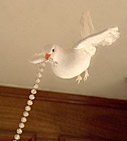
I always hang doves from the ceiling with strings of beads in their mouths as though they were flying in and decorating the tree. I use white thread to suspend the birds and pushpins to secure them to the ceiling. You can attach the beads to the birds’ beaks with hot glue or with straight pins. They can also be attached to the feet. The string of beads should be long enough to drape the end over a limb of the tree. Place the doves at different distances from the Christmas tree.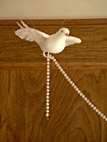
The end result should look like the doves are decorating the tree with beads. I also like to have one or two of the doves carrying Christmas ornaments attached to their feet. Of course the Christmas tree is already decorated with several well-placed doves among the other Christmas ornaments.
In addition to hanging birds from the ceiling and placed throughout the tree, I place bird nests filled with tiny decorative eggs. Naturally I also put a little mama bird in the nest as well, to keep the little eggs warm and comfy.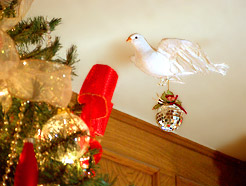
Children love seeing the doves "decorating" the tree. Every Christmas it’s a special treat searching for the little bird’s nest with all the tiny little eggs.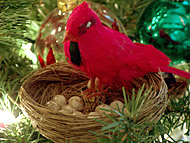
And of course, it’s a special treat for me just watching the children expore the tree, rearranging the eggs, rearranging the birds and trying to make the doves really fly.
What you will need for hanging your birds:
* White thread
* Two pushpins for each bird
* Two straight pins for each bird
* Optional hot glue
Bird Hanging Tips:
Hanging the birds in a manner that looks natural and graceful can be tricky. Here are some quick tips:
* Use thread that is the least visible when hanging from the ceiling. I use white cotton thread.
* Attach two strings of thread to the bird’s back.
* Cut the strings long enough to reach from the ceiling to the level you want your bird to hang. Cut twice as much thread as you think you’ll need. It’s easy to cut off extra, but it can be frustrating to have to start over.
* Wrap the first thread around a straight pin with a white ball head. Insert the pin at an angle near the head of the bird. The white head of the pin should be toward the head of the dove and inserted toward the tail. The angle is important in preventing the thread from slipping out when the bird is hung.
* Wrap thread around a second pin and insert at an angle, but this time the white head will be near the tail and inserted toward the head.
* You now have two threads inserted in the back of the dove. Wrap the end of each thread around a clear pushpin to be inserted in the ceiling. You can adjust the distance of the dove from the ceiling by adjusting the number of turns around the pushpin.
* When your threads and pins are in place and the birds are ready for hanging, you can temporarily insert the ceiling pushpins in the back of the birds. When you’re at the top of your ladder and you’re ready to hang your doves, just remove one pushpin at a time and insert in the ceiling.
* After hanging your birds to the ceiling, if they are not hanging in the direction you intended, you can control the direction by repositioning one of the strings.
* Occasionally, repositioning the beads they carry in their mouths or feet, to a different limb on the tree can also help to control the direction.
Hanging birds & beads from the ceiling can be an added dimension to your Christmas tree decorating. Just remember to not over do it, be safe and have fun.
Here are some pictures to show you what the finished Christmas Tree will look like:
Source: http://teamsugar.com/user/sugarpopsosweet/blog/855900

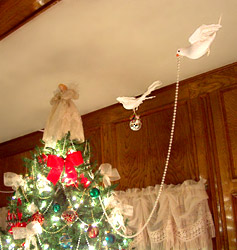
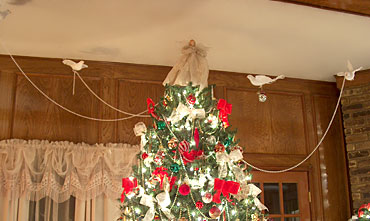
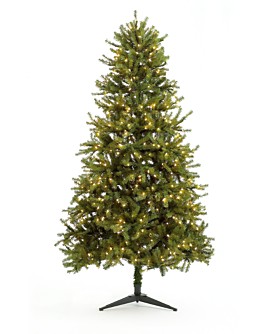
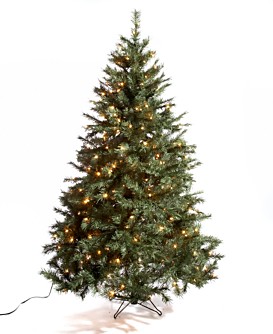





 Voted # 5 - Scotch Pine - Scotch or "Scots" pine is the most planted commercial Christmas tree in North America according to NCTA. However, this survey does not suggest that it is the most popular. A true pine, Scots pine was imported from Europe and is not native to America. It was first used in reforestation efforts in the New World. Scotch pine tree has stiff branches, two bundled dark green needles 1 to 3 inches long that are retained for four weeks. The aroma is long-lasting and lingers through the entire season. Scotch pine does not drop needles when dry - excellent retention. Photo courtesy NCTA.
Voted # 5 - Scotch Pine - Scotch or "Scots" pine is the most planted commercial Christmas tree in North America according to NCTA. However, this survey does not suggest that it is the most popular. A true pine, Scots pine was imported from Europe and is not native to America. It was first used in reforestation efforts in the New World. Scotch pine tree has stiff branches, two bundled dark green needles 1 to 3 inches long that are retained for four weeks. The aroma is long-lasting and lingers through the entire season. Scotch pine does not drop needles when dry - excellent retention. Photo courtesy NCTA.




